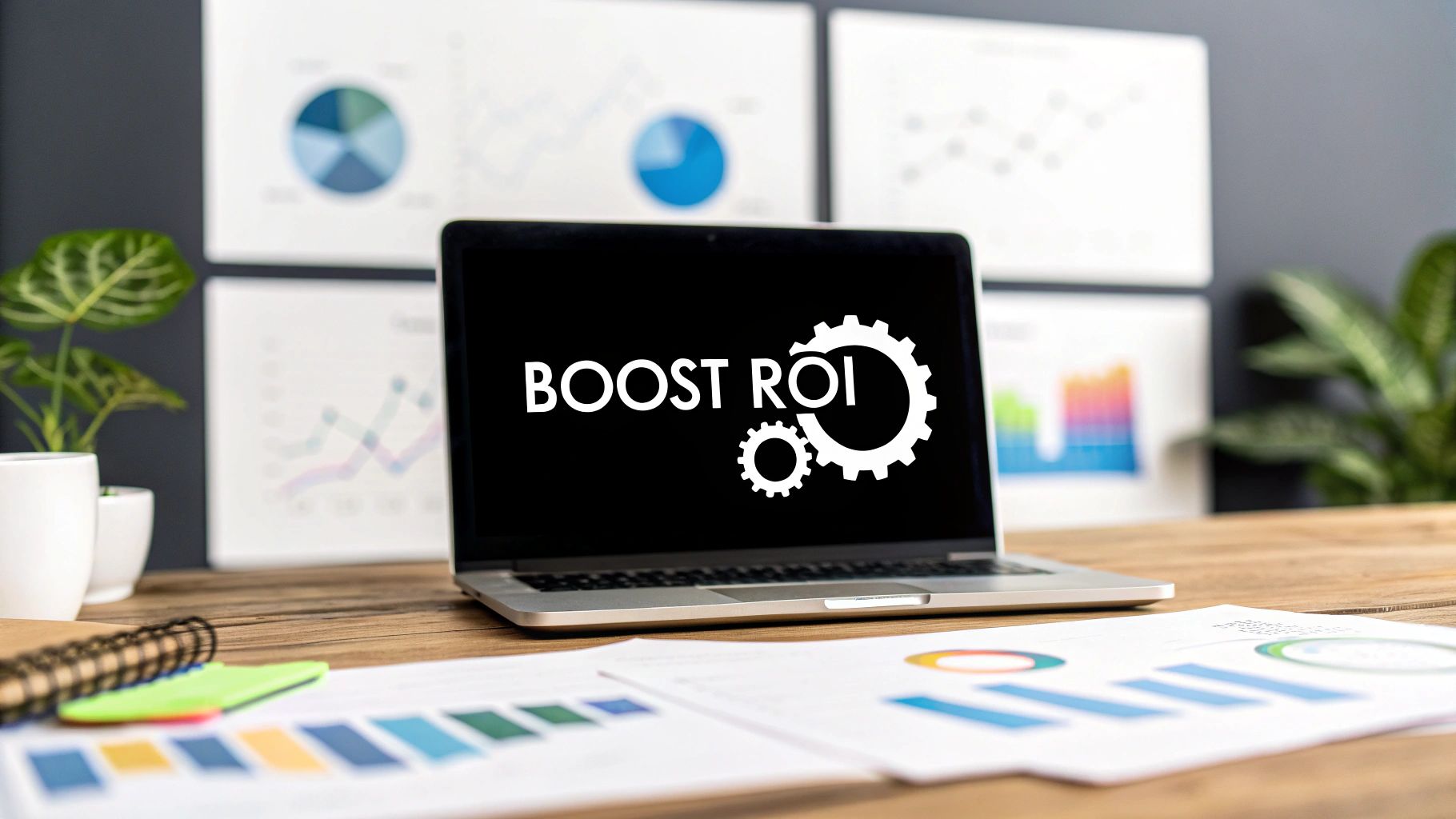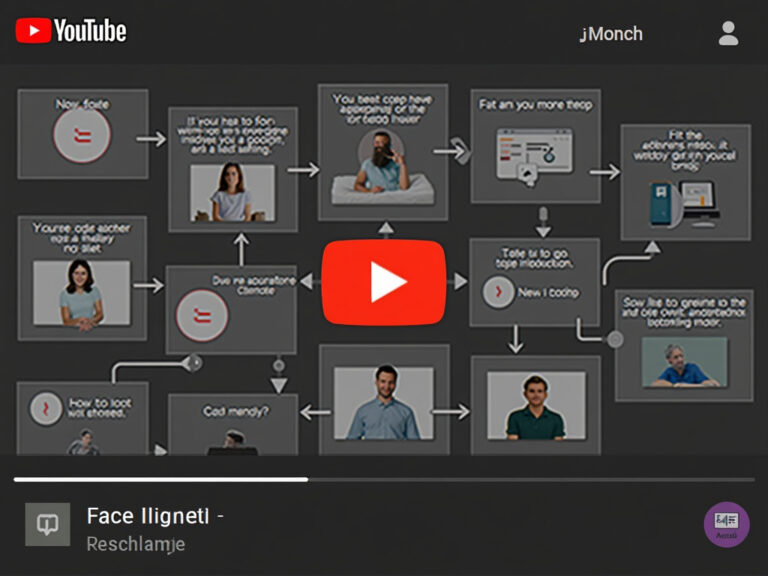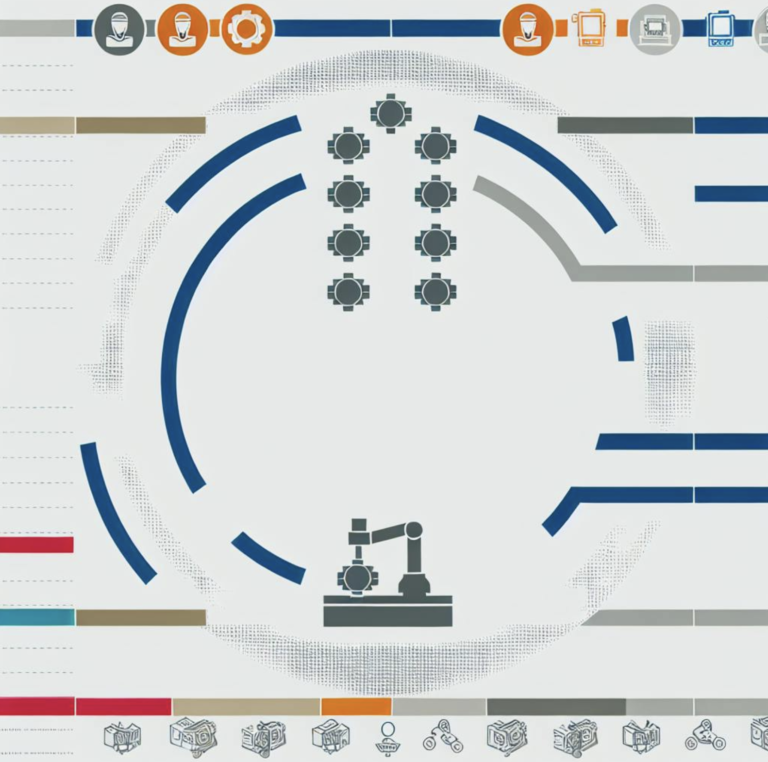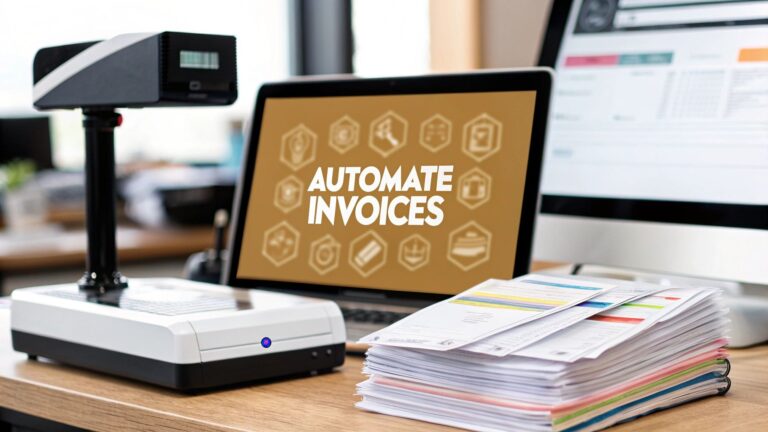Maximize ROI of Marketing Automation: Boost Your Results
The real value of marketing automation isn't just one thing. It's a powerful mix of direct revenue gains, massive time savings, and a smoother, more efficient operation overall. It's about more than just profit; think about the tangible cost cuts from automating repetitive tasks and the harder-to-measure benefits like a happier, more productive team making fewer mistakes. To see the true impact, you have to look at the entire business.
Defining Your Marketing Automation ROI

Before you can even think about calculating your return, you have to define what "success" actually means for your company. Measuring the ROI of marketing automation isn't a simple plug-and-play formula. It's about grasping the full picture of the value it brings to the table. This means looking past the obvious financial wins to uncover the hidden operational improvements that really drive sustainable growth.
I’ve seen too many businesses get hung up on vanity metrics like email open rates, completely missing the forest for the trees. A true ROI calculation is holistic; it has to account for both the hard numbers and the qualitative gains that don't fit neatly on a spreadsheet.
The Tangible and Intangible Wins
Tangible ROI is the stuff you can count—the hard numbers that show up on your P&L statement. These metrics are absolutely essential for proving financial impact to your leadership and justifying your marketing budget.
Think about metrics like:
- Increased Revenue: This is the most straightforward one. How much new sales revenue can you trace directly back to your automated campaigns, upsells, and cross-sells?
- Higher Conversion Rates: By nurturing leads more effectively and consistently, automation helps turn more prospects into paying customers. This directly boosts your bottom line.
- Lower Cost Per Acquisition (CPA): When you automate lead generation and nurturing, you cut down on the manual hours and ad spend required to land a new customer.
On the flip side, intangible ROI is just as crucial, even if it's tougher to pin down. These are the operational and cultural shifts that make your team more effective and your business more scalable. Marketing automation is really a specialized application of a bigger concept; understanding how to automate business processes in a general sense provides a solid framework for thinking about its value.
Think of it this way: Tangible ROI is the fruit you harvest, while intangible ROI is the health of the tree that produces it. If you ignore the health of the tree, you'll eventually get a much smaller harvest.
Setting a Clear Baseline for Success
To measure any kind of improvement, you need to know where you started. This means taking a snapshot of your key metrics before you go all-in on your automation strategy. Without this baseline, you're just guessing at your impact.
For instance, take the time to document your current lead-to-customer conversion rate, the average length of your sales cycle, and exactly how many hours your team spends on manual follow-ups each week. This baseline becomes your yardstick. Everything you do from this point forward can be measured against it, giving you clear, defensible proof of what your automation efforts have achieved.
Core Metrics for Marketing Automation ROI
To truly capture the full impact, you need a balanced scorecard. I’ve put together this table to break down the essential metrics—both tangible and intangible—that give you a complete view.
| Metric Category | Specific Metric | What It Tells You |
|---|---|---|
| Revenue & Sales | Customer Lifetime Value (CLV) | How automation increases the long-term value of each customer through retention and upsells. |
| Revenue & Sales | Sales Cycle Length | Whether your automation is effectively speeding up the journey from lead to closed deal. |
| Efficiency & Cost | Cost Per Lead (CPL) | The direct impact of automation on the cost-efficiency of your lead generation efforts. |
| Efficiency & Cost | Hours Saved on Manual Tasks | The operational gain from automating repetitive work, freeing up your team for strategic initiatives. |
| Lead Management | Lead-to-MQL Conversion Rate | How well your top-of-funnel automation is qualifying and nurturing new leads. |
| Lead Management | MQL-to-SQL Conversion Rate | The effectiveness of your lead scoring and handoff process between marketing and sales. |
| Intangibles | Team Morale/Satisfaction | A qualitative measure of how automation reduces tedious work and empowers your team. |
| Intangibles | Reduction in Human Error | The improvement in data accuracy and campaign consistency due to automated workflows. |
Looking at these metrics together prevents you from developing tunnel vision. A drop in CPL is great, but it’s even better when paired with a shorter sales cycle and a happier, more focused team. This comprehensive approach is how you tell the full story of your success.
How to Calculate Your Automation ROI
Figuring out the actual ROI of your marketing automation can feel like a huge task, but it really just comes down to a classic formula. The real challenge isn't the math—it's getting an honest, complete picture of all the costs and all the gains.
This chart lays out the three main components you'll need to pull together to get your final number.
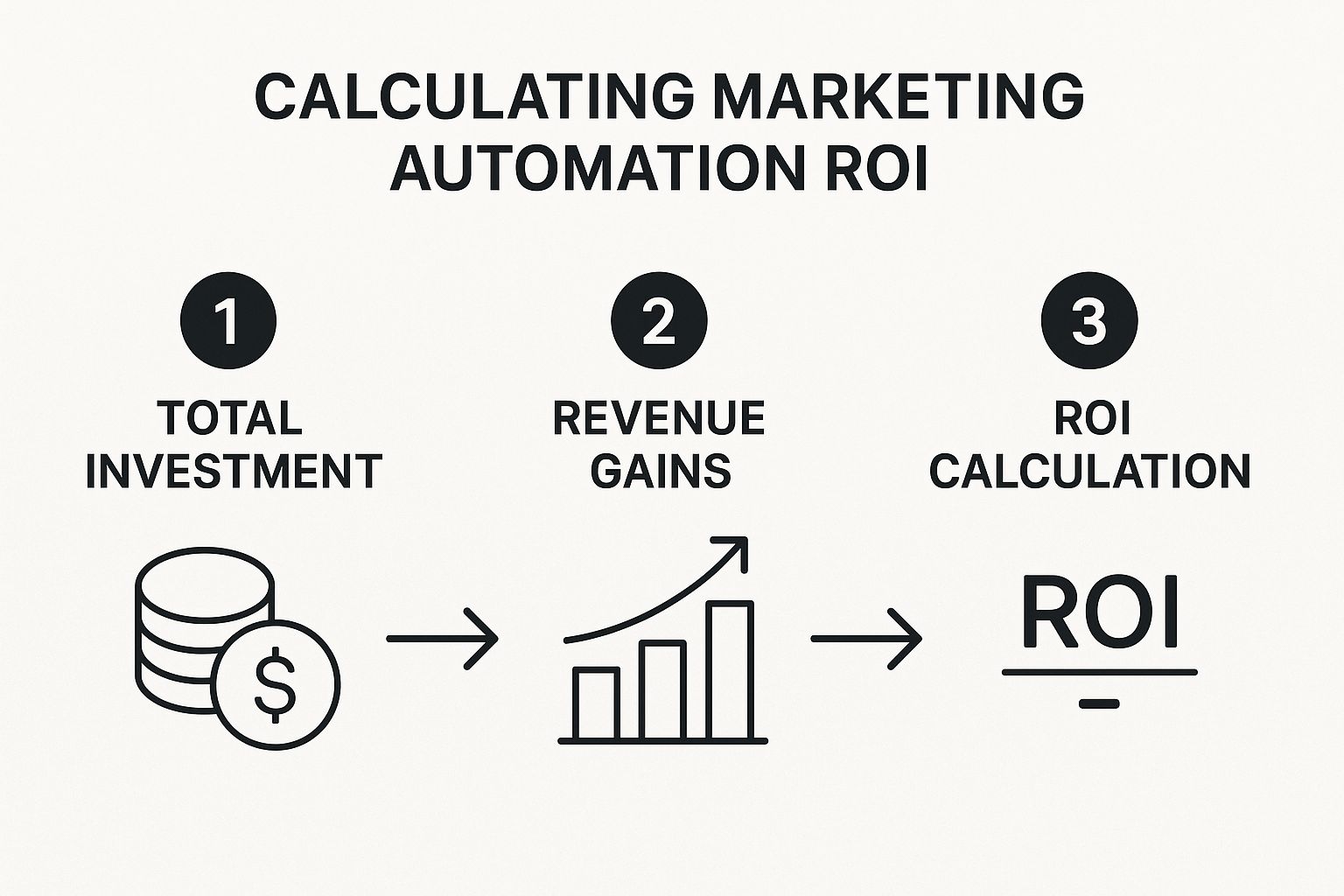
As you can see, it's about gathering your total investment, measuring the revenue boost, and then plugging those into the final formula.
The standard ROI calculation itself is beautifully simple: (Net Return / Cost of Investment) x 100. This is the bedrock we'll build on, adapting it specifically for marketing automation.
Pinpointing Your Total Investment
First up, you have to get real about every single dollar and hour spent on your automation platform. This is way more than just the monthly bill. If you're not brutally honest here, you’ll end up with an inflated ROI that looks great on paper but doesn't reflect reality.
Your total investment needs to include:
- Software Fees: This is the easy one. It's your monthly or annual subscription cost.
- Implementation and Setup Costs: Did you hire a consultant or pay a one-time fee to get started? That goes in the pot.
- Internal Team Hours: This is the cost everyone forgets. You need to calculate the hours your team sunk into training, initial setup, and building out the first wave of campaigns. Just multiply those hours by their hourly wage.
- Content Creation: Don't forget the time and money spent creating the emails, landing pages, and other assets that actually make your automation work.
For a much deeper look at the whole process—from calculation to benchmarking and beyond—check out this comprehensive guide to Marketing Automation ROI.
Quantifying Your Revenue Gains
With your costs tallied, it's time to measure the financial wins that came directly from your automation efforts. This is where solid tracking and attribution become non-negotiable. You absolutely have to connect your automation platform to your CRM to see which leads, nurtured through your automated sequences, actually converted into paying customers.
Email is often the star player here. A huge chunk of marketing automation ROI is driven by automated email campaigns that nurture leads from lukewarm to sales-ready. One report even found that for every $1 spent on email marketing, you could see a return of $36. That's a mind-boggling 3600% ROI, and it shows just how powerful a well-oiled automated email strategy can be.
Your whole goal is to connect the dots. A prospect downloads an ebook, gets dropped into a 5-part email nurture sequence, and three weeks later, they book a demo with your sales team. The revenue from that closed deal is a direct gain from your automation investment.
Bringing It All Together: A B2B Scenario
Let's walk through a realistic example for a SaaS company to see how this works in the real world.
Investment Calculation:
- Annual Software Cost: $6,000 ($500/month)
- Implementation (Team Hours): 40 hours x $50/hour = $2,000
- Ongoing Management & Content (Team Hours): 10 hours/month x 12 months x $50/hour = $6,000
- Total Annual Investment: $14,000
Gain Calculation:
- Deals Closed from Nurture Campaigns: 20 deals
- Average Deal Size: $3,000
- Total Attributed Revenue: 20 x $3,000 = $60,000
Now, we just pop these numbers into our formula:
ROI = (($60,000 – $14,000) / $14,000) x 100
ROI = ($46,000 / $14,000) x 100
ROI = 328.57%
There you have it. A clear, defensible number showing that for every dollar they put into marketing automation, the company got nearly $3.29 back. That’s a number you can confidently take to your next leadership meeting.
Measuring Efficiency Gains and Team Productivity

A huge part of your marketing automation ROI doesn’t show up as a new sales figure. It shows up in reclaimed hours, happier teams, and smarter work. These so-called "soft" benefits, like cutting down on manual tasks, translate directly into hard financial gains through a more efficient and productive team.
Think about the daily grind. Manually scoring leads, sending one-off follow-up emails, and slicing up contact lists aren't just tedious—they're massive time sinks. Automation takes these repetitive jobs off your team's plate, freeing them up for what really matters: strategy, creative campaigns, and building real customer relationships.
Putting a Number on Time Savings
First things first, you need to figure out just how much time your team is getting back. This isn't a fluffy metric; it's a core piece of your ROI calculation. Start by auditing the tasks you're planning to automate.
Let’s say your marketing specialist spends about five hours every week manually nurturing leads through email. Automating that workflow instantly saves 20 hours per month. Simple as that.
Now, turn those hours into dollars. If that specialist earns $30 per hour, you’ve just created an efficiency gain of $600 per month. That’s $7,200 a year, straight back to your bottom line, from just one automated process.
From Efficiency to Innovation
Here’s where the magic really happens. What does your team do with all that extra time? When marketers aren't buried in administrative work, they start to innovate. This reclaimed time gets reinvested into activities that drive even bigger returns.
- Deeper Customer Research: They finally have the time to really understand your buyer personas and their pain points.
- A/B Testing and Optimization: They get the bandwidth to run experiments on email subject lines, landing pages, and special offers.
- Strategic Planning: They can step back and develop long-term campaigns instead of just putting out fires every day.
The real compounding value of automation is this shift from reactive, manual work to proactive, strategic thinking. You're not just saving money on hours worked; you're investing those hours into smarter, more profitable marketing.
The impact here is massive. Studies show that 22% of marketers see an efficiency boost of over 35% after adopting automation. But it's more than just speed. Marketers using automation report less burnout (48.8%), fewer errors (33.2%), and a big jump in confidence (34.8%). All of this creates a more engaged and effective team.
This productivity boost isn't a one-off win; it helps you build a more sustainable and scalable marketing engine. For more ideas on this topic, check out our guide on how to increase team productivity with smart systems. Ultimately, tracking these efficiency gains is a critical piece of proving the total ROI of marketing automation.
If you've already found your groove with marketing automation, get ready for the next leap. Bringing artificial intelligence into the mix isn't just an upgrade; it's like giving your entire marketing engine a new brain. We're moving past the "if-this-then-that" rules and into a world where your platform can predict, adapt, and learn. This is where the ROI of marketing automation really starts to take off.
Think of it this way: AI can sift through thousands of subtle signals—every click, download, and page view—to figure out which leads are actually ready to talk to sales. It stops your team from wasting time on dead ends and points them directly to the people most likely to buy. That alone can shorten your sales cycle and bump up your close rates.
Predictive Lead Scoring and Next-Level Personalization
One of the quickest wins you'll see is with AI-driven lead scoring. Forget manually setting up rules like "+5 points for a webinar signup." An AI model looks at everything at once, creating a dynamic, real-time score that truly reflects a lead’s intent. Suddenly, your sales pipeline is consistently filled with the highest-quality opportunities.
But it goes way beyond just scoring. AI makes hyper-personalization a reality, even with thousands of contacts. It can tweak your website on the fly for a specific visitor, suggest the perfect piece of content, or adjust the timing of an email based on an individual's behavior. This makes your marketing feel genuinely helpful, not automated. When you dig into how AI can amplify your automation ROI, you'll find that better content is a huge piece of the puzzle. Checking out some of the latest AI content creation tools can give you a serious edge here.
Real-World ROI From Smarter Automation
So, what does this look like on the balance sheet? The numbers speak for themselves.
With digital interactions expected to make up 80% of B2B sales by 2025, companies using AI-powered automation are already seeing ROI jump by 10-20%. This boost comes from a few key areas:
- Wiping out tedious, repetitive tasks.
- Slashing human error by around 20%.
- Giving your best people the time to focus on high-level strategy.
You can find more data on this in these insightful sales automation statistics on kixie.com.
AI doesn't just make your automation work faster—it makes it work smarter. It zeros in on the things that actually drive ROI: converting more leads, growing deal sizes, and making your whole team more efficient.
Getting started might sound intimidating, but you don't need a team of data scientists. Many of the best marketing automation platforms now have user-friendly AI features built right in. If you're curious about the mechanics behind it all, this guide on how to create an AI program is a great place to understand the fundamentals.
By embracing AI, you’re turning your automation platform from a simple instruction-follower into a strategic partner that anticipates customer needs and delivers much stronger results.
Strategies to Continuously Improve Your Returns

Calculating your initial ROI is a great start, but it's just the baseline. The real magic of marketing automation happens when you stop seeing it as a tool and start treating it as a dynamic engine for growth. This isn't a "set it and forget it" solution; it's a living part of your marketing that needs constant tuning to perform at its peak.
The goal here is to turn your automation platform into a true growth driver. By making small, smart changes over time, you can steadily increase the ROI of marketing automation year after year. It’s all about continuous improvement.
Foster a Culture of Constant Testing
If there's one thing I've learned, it's that assumptions kill ROI. The single best way to boost your returns is to test everything. Don't guess which email subject line will work best—let your audience's actions give you the answer.
Start by building a systematic A/B testing schedule for your most important assets. This shouldn't be about running random experiments whenever you feel like it. It's about creating a structured process to find those small, incremental wins that add up.
- Email Campaigns: Test your subject lines, sender names, send times, and of course, the CTA button copy. Even a tiny lift in open rates can make a huge difference down the line.
- Landing Pages: Experiment with different headlines, form lengths, images, and social proof. Your objective is always to remove friction and make it easier for people to convert.
- Workflow Logic: Play with the timing and number of touchpoints in your nurture sequences. Do leads respond better to a 5-day cadence or a 7-day one? Only testing will tell you for sure.
Adopting this mindset shifts your team from just executing tasks to actively solving problems, which is the key to mastering your strategy. You can find more ideas for building effective automated systems in these detailed marketing automation best practices.
Refine Segmentation for Hyper-Relevance
Generic messages get ignored. The good news is, as you gather more data, you can graduate from basic segmentation (like industry or company size) to far more powerful, behavior-based groups.
Think about segmenting your audience based on things like:
- The specific whitepaper they just downloaded.
- The features they use most often inside your app.
- How engaged they were with your last three emails.
This kind of detail lets you send hyper-relevant messages that hit on a contact's immediate needs. When your communication feels personal and timely, it builds trust and moves people through the pipeline much faster.
A great return on investment doesn't come from sending more emails; it comes from sending smarter ones. Advanced segmentation ensures every message has a purpose and a high probability of resonating.
Create a Sales and Marketing Feedback Loop
Your sales team is sitting on a goldmine of intelligence that can boost your ROI. They're on the front lines, talking to the very leads your automation platform nurtured. If your marketing team is working in a silo, they're essentially flying blind.
Set up a regular, structured feedback process. This could be a quick weekly or bi-weekly sync where sales shares what they’re hearing. Are the leads well-informed? What are the common objections? Are they actually ready for a sales call?
This direct feedback is invaluable. It helps marketing continuously tweak lead scoring models and adjust the content in nurture tracks to better prepare prospects. It closes the loop, making sure your automation isn't just generating activity, but consistently delivering high-quality, sales-ready opportunities that actually drive revenue.
Common Questions About Marketing Automation ROI
https://www.youtube.com/embed/AM5MmEa_Z84
Even with a solid plan, you're bound to run into some tricky questions when trying to pin down the ROI of your marketing automation. Let's tackle some of the most common ones I hear from clients, offering straight answers to help you get your own calculations right.
How Long Does It Take to See a Positive ROI?
This is the million-dollar question, isn't it? The honest answer is, it really depends. The single biggest factor influencing your timeline is the length of your sales cycle.
-
Shorter Sales Cycles (think B2C or simple B2B products): You could start seeing a positive return in as little as 3-6 months. When the path from lead to customer is short, you can quickly measure the impact of things like automated welcome emails or abandoned cart sequences on the bottom line.
-
Longer Sales Cycles (typical for complex B2B/SaaS): A more realistic timeframe is closer to 9-12 months, sometimes even longer. It simply takes time to build your database, execute multi-touch nurturing campaigns, and guide prospects through a more considered buying journey.
The key here is patience. You're building a growth engine, not looking for a one-off campaign bump. Rushing it usually means sloppy execution and campaigns that don't produce any real return.
What Are the Biggest Hidden Costs in an ROI Calculation?
This is a classic pitfall. Too many businesses look only at the monthly software subscription and call it a day. That mistake leads to an inflated, unrealistic ROI that doesn't reflect the true cost of the initiative.
To get an accurate number, you have to account for your human capital.
The most significant hidden cost is almost always your team's time. Don't forget to factor in the hours spent on setup, training, and the day-to-day management of the platform. You also have to consider the cost of creating new content for your campaigns and potentially hiring an expert for a tricky implementation.
Forgetting to track these hours is like calculating the cost of a road trip without factoring in the price of gas. You're missing a huge piece of the puzzle. An honest ROI calculation includes every single resource you put into the project.
Can Small Businesses Actually Get a High ROI?
Absolutely. In fact, for many small and mid-sized businesses, marketing automation can be a complete game-changer. The impact is often even greater than in a large enterprise.
Many of today's best automation tools are built and priced specifically for smaller teams, so the initial investment is far more manageable.
For SMBs, the biggest and fastest return often comes from simple efficiency. When you have a small team, every hour is precious. By automating those repetitive, soul-crushing tasks, you free up your people to focus on what actually grows the business—talking to customers, closing deals, and thinking strategically.
You don't need a massive, complex system from day one. Starting with a simple automated welcome series or a basic lead nurturing sequence can deliver a measurable, positive return surprisingly quickly.
Ready to stop wasting time on manual tasks and start seeing a real return on your marketing efforts? MakeAutomation specializes in building and implementing the exact AI and automation systems B2B and SaaS companies need to scale. We help you reclaim your time and accelerate growth. Optimize your workflows with us today.

